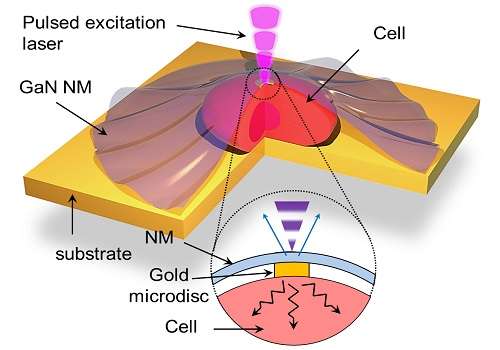Nano-sized sensors provide unprecedented data on how heat diffuses in and out of living cells

Tiny flat sensors that stick to the surface of living cells can provide detailed measurements of heat transfer at the cell surface. Developed at King Abdullah University of Science and Technology (KAUST), Saudi Arabia, these new sensors resolve some of the practical challenges of working with these tiny cells as well as enable novel diagnostic techniques.
Professor Boon Ooi, his Ph.D. student Rami Elafandy and co-workers developed these sensor devices from gallium nitride nanomembranes that are just 40 nanometers thick. They also show that the sensors can identify different types of cancer cells.
ElAfandy explains that optical, mechanical and electrical properties of living cells have been extensively studied and yet there is little data of their thermal properties, mainly because of the challenges of working with tiny cell volumes and irregular cellular shapes.
"Cells have irregular curved contours, meaning it's difficult to have a firm contact with them without damaging their membranes," said ElAfandy. "We utilized the high flexibility of nanomembranes to follow the cellular contours and minimize any temperature drops within the cell-sensor interface that would yield errors."
After attaching the sensor to the cell surface, the researchers applied a pulsed ultraviolet laser beam, heating the nanomembrane and causing a photoluminescent emission of light at a frequency dependent on the temperature of the nanomembrane. This temperature, in turn, depended on how well the heat was transferred into the cell.
Therefore, by measuring the frequency of the photoluminescent light, the researchers could calculate not only the thermal conductivity of the cells—how well they allow heat to flow—but also the thermal diffusivity, which takes into account how well the cell stores thermal energy.
First, however, there was one practical challenge to overcome: "The lasers we use can cause fatal damage to cells and the nanomembranes are too thin to absorb all of the hazardous laser light," said ElAfandy. "We solved this by inserting a thin gold disc between the nanomembrane and the cell to absorb all the laser radiation transmitted while allowing heat to diffuse from the nanomembrane to the cell."
During tests, the researchers identified strong differences in thermal diffusivity between breast and cervical cancer cells as well as between sub-types of breast cancer cells.
"Our devices are unusual in that they measure thermal conductivity and diffusivity simultaneously to yield a better description of heat transport within cells," said Ooi. "We hope to increase the spatial resolution to scan within cells and collect information on individual cellular organelles. With some major modifications, one day it might even be possible to measure thermal transport within the human body."
More information: Rami T. ElAfandy et al. Nanomembrane-Based, Thermal-Transport Biosensor for Living Cells, Small (2017). DOI: 10.1002/smll.201603080
Journal information: Small



















